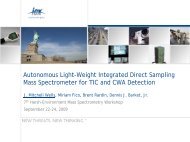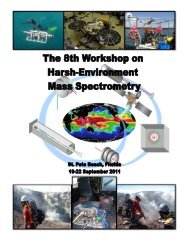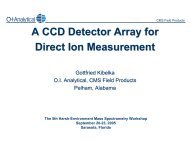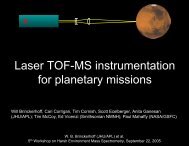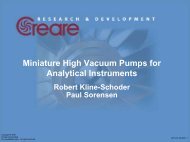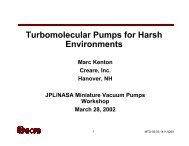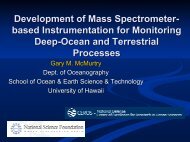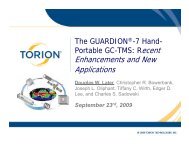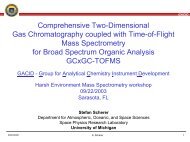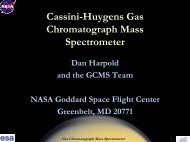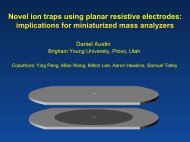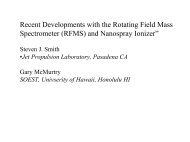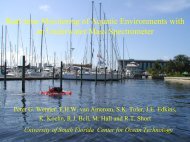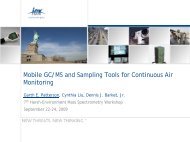Underwater Mass Spectrometry: Developments and Calibration
Underwater Mass Spectrometry: Developments and Calibration
Underwater Mass Spectrometry: Developments and Calibration
You also want an ePaper? Increase the reach of your titles
YUMPU automatically turns print PDFs into web optimized ePapers that Google loves.
<strong>Underwater</strong> Membrane <strong>Mass</strong><br />
<strong>Spectrometry</strong>: <strong>Developments</strong> <strong>and</strong><br />
<strong>Calibration</strong><br />
Ryan J. Bell, R. Timothy Short, Strawn K. Toler,<br />
Friso H.W. van Amerom, Peter G. Wenner, <strong>and</strong><br />
Robert H. Byrne<br />
SRI International<br />
&<br />
University of South Florida<br />
College of Marine Science
Acknowledgements<br />
• Faculty, staff <strong>and</strong> students at SRI International, the<br />
Center for Ocean Technology <strong>and</strong> College of<br />
Marine Science.<br />
• Funding from U.S. Office of Naval Research<br />
(ONR) Grant No. N00014-03-1-0479 <strong>and</strong><br />
Contract No. N00014-07-C-0720.<br />
• Skidaway Institute of Oceanography<br />
• Google Maps
In Situ <strong>Underwater</strong> Membrane<br />
Introduction <strong>Mass</strong> <strong>Spectrometry</strong> at USF<br />
& SRI International<br />
1. Description of <strong>Underwater</strong> Membrane Introduction MS<br />
2. <strong>Calibration</strong> Methodology<br />
3. Surface Contour Deployments<br />
4. Depth Profile Deployments<br />
5. Benthic Moored Deployments
MS: Versatile Chemical Sensor<br />
• Trace Elements<br />
• Isotope Ratios<br />
• Pollutants/VOCs<br />
• Dissolved Gases<br />
• Proteins/Amino Acids<br />
• Bacterial Signatures<br />
No configuration valid for all analytes
Membrane Introduction <strong>Mass</strong> <strong>Spectrometry</strong><br />
(MIMS)<br />
Ion source<br />
Electron impact<br />
<strong>Mass</strong>-filter<br />
Quadrupole<br />
Detector<br />
Electron multplier<br />
Membrane<br />
e -<br />
+<br />
+<br />
Ion <strong>and</strong><br />
fragments<br />
<strong>Mass</strong>-scan
Simultaneous Detection of Multiple Analytes<br />
• Dissolved Gases<br />
– e.g. Nitrogen, Oxygen, Argon, Carbon Dioxide,<br />
Methane, Hydrogen Sulfide<br />
• Volatile Organic Compounds<br />
– e.g. Toluene, Benzene, Dimethyl Sulfide,<br />
Chloroform<br />
• Larger MW Compounds with Modification<br />
– e.g. PCBs, Pesticides, Drugs, Toxins
Principle Features of UMS<br />
Type<br />
Linear quadrupole mass filter<br />
<strong>Mass</strong> range<br />
200 amu<br />
Inlet System<br />
Membrane introduction system<br />
Power consumption 100 Watts<br />
Voltage of operation 24 VDC or 110 VAC<br />
Deployment time Configuration dependent<br />
Dimensions ∅ 19 cm (7.5”)<br />
L 105 cm (41’’)<br />
Weight<br />
33 kg (72.7 Lb)<br />
Depth<br />
>1000 m<br />
DSL tether range ~1600 m (1 mile)
New 200 amu In Situ <strong>Mass</strong> Spectrometer<br />
Microcontroller<br />
Embedded PC<br />
MS electronics box<br />
200 amu linear quadrupole in<br />
vacuum housing w/ heating jacket<br />
Turbo pump<br />
MIMS probe<br />
Roughing pump
Membrane Assembly
<strong>Calibration</strong> - Instrument Parameters<br />
• Physical parameters that affect instrument response:<br />
– Detector settings<br />
– Filament settings<br />
– Membrane geometry<br />
– Residual gas<br />
– Membrane temperature<br />
– Sample velocity<br />
Constant during deployment<br />
– Hydrostatic pressure<br />
Variable during deployment
Laboratory <strong>Calibration</strong> - Pressure <strong>and</strong><br />
Concentration<br />
• An HPLC pump <strong>and</strong> back pressure regulator allow control of<br />
hydrostatic pressure for pressure calibrations<br />
• Two solutions with known gas<br />
concentrations are mixed at<br />
various ratios to allow for<br />
intermediate concentrations <strong>and</strong> in<br />
situ automated calibration
<strong>Calibration</strong> Results<br />
Nitrogen (m/z 28)<br />
Oxygen (m/z 32)<br />
Methane (m/z 15)<br />
<strong>Calibration</strong> Normalized at 200atm 1atm Response (78% N2, vs Pressure 21% O2, 1% (atm) CH4) 2/18/05<br />
2/18/05<br />
Instrument<br />
Normalized<br />
Response<br />
Response<br />
(A)<br />
Instrument Response (A)<br />
1.00E-07 1.20 1.0000E-07<br />
9.00E-08 9.0000E-08<br />
1.00<br />
8.00E-08 8.0000E-08<br />
7.00E-08 7.0000E-08<br />
0.80<br />
6.00E-08 6.0000E-08<br />
5.00E-08 0.60 5.0000E-08<br />
4.00E-08<br />
4.0000E-08<br />
0.40<br />
3.0000E-08<br />
3.00E-08<br />
Oxygen<br />
y = 1.742E-10x + 2.143E-08<br />
R 2 = 9.999E-01<br />
Oxygen<br />
y = 7.056E-11x + 1.690E-08<br />
R 2 = 9.994E-01<br />
Nitrogen<br />
y = 1.821E-10x + 5.175E-09<br />
R 2 = 9.999E-01<br />
2.0000E-08<br />
R 2 = 9.939E-01<br />
2.00E-08 0.20<br />
1.0000E-08<br />
1.00E-08<br />
y = 1.593E-10x + 1.573E-10<br />
Methane<br />
y R= 2 6.512E-11x = 9.995E-01+ 7.765E-11<br />
0.00 0.0000E+00<br />
Methane<br />
R 2 = 9.962E-01<br />
0.00E+00<br />
0 100 200 300 400 500 600<br />
0 0 100 50 200 100 300 150 400 200 500 250 600<br />
Concentration (umole/kg)<br />
Hydrostatic Concentration Pressure (umole/kg) (atm)<br />
Methane<br />
Nitrogen<br />
Nitrogen<br />
Oxygen y = 7.176E-11x + 3.614E-09
<strong>Calibration</strong> Results - Pressure
Field <strong>Calibration</strong><br />
• Three or more field samples are sparged at constant<br />
temperature with gas st<strong>and</strong>ards of various concentrations.<br />
• Each st<strong>and</strong>ard is sampled prior to deployment<br />
Field Baseline Determinations<br />
• Oxygen baseline is determined by the addition of sodium<br />
sulfite to solution.<br />
• Carbon dioxide baseline is determined by the addition of<br />
sodium carbonate to solution.
Field Baseline Determination<br />
• Baselines for nitrogen, argon, <strong>and</strong> methane, are determined<br />
by stopping the sample pump, whereupon sample in<br />
contact with the membrane is completely degassed<br />
• Pump stop method is compared to sampling of boiling water<br />
for baseline determination.
Stopping Sample Pump<br />
• Comsol Multiphysics (finite element) model of sample degassing<br />
during stopped sample flow at the membrane surface<br />
40 mm<br />
2.5 mm<br />
Vacuum<br />
Membrane<br />
Membrane<br />
16x Scale
Pre-Deployment <strong>Calibration</strong>
1.00E-07<br />
1.00E-08<br />
1.00E-09<br />
1.00E-10<br />
1.00E-11<br />
1.00E-12<br />
0 100 200 300 400 500 600 700<br />
Scan #<br />
2 . 2 e - 1 0<br />
2 . 0 e - 1 0<br />
1 . 8 e - 1 0<br />
1 . 6 e - 1 0<br />
1 . 4 e - 1 0<br />
1 . 2 e - 1 0<br />
1 . 0 e - 1 0<br />
8 . 0 e - 1 1<br />
6 . 0 e - 1 1<br />
4 . 0 e - 1 1<br />
2 . 0 e - 1 1<br />
0 . 0<br />
1 7 : 0 0 F r id a y<br />
0 2 0 0 0 4 0 0 0 6 0 0 0 8 0 0 0 1 0 0 0 0 1 2 0 0 0 1 4 0 0 0 1 6 0 0 0 1 8 0 0 0<br />
S c a n N u m b e r ( 7 s e c / s c a n )<br />
1 7 :0 0 S a tu rd a y<br />
Deployment Methods<br />
W a s t e W a t e r I n f lu e n t<br />
m / z 9 1<br />
Intensity (Amps)<br />
AUV<br />
USV<br />
Moored<br />
Intensity<br />
ROV<br />
Depth Profiling<br />
Diver
Lake Maggiore Chemical Surveys<br />
O 2<br />
Ar<br />
CO 2<br />
• <strong>Mass</strong> spectrometer deployed<br />
aboard an unmanned surface<br />
vehicle<br />
• Mapping variation of<br />
dissolved gas ion intensities<br />
• Develop surface contour maps<br />
based on gas ion intensity data<br />
• Carbon dioxide & oxygen<br />
data displayed
Lake Maggiore, St Petersburg, FL<br />
O 2 <strong>and</strong> CO 2 are inversely correlated in areas of<br />
active photosynthesis <strong>and</strong> respiration<br />
m/z 32 - Oxygen<br />
m/z 44 - Carbon Dioxide
Hillsborough River, February 2007
Hillsborough Deployment Method
Hillsborough Deployment Method
300<br />
Oxygen Time Series<br />
Conc. (mmole/kg)<br />
250<br />
200<br />
150<br />
100<br />
50<br />
0<br />
YSI Dissolved Oxygen Sensor<br />
MS m/z 32<br />
MS m/z 32 - Argon Corrected<br />
2:24 PM 3:21 PM 4:19 PM 5:16 PM 6:14 PM<br />
Time
Oxygen<br />
3 : 2 1 P M 4 : 1 9 P M 5 : 1 6 P M<br />
296 mmole/kg<br />
157 mmole/kg
Oxygen at Sulfur Springs
Carbon Dioxide<br />
204 mmole/kg<br />
3:21 PM 4:19 PM 5:16 PM<br />
151 mmole/kg
Methane<br />
3 : 2 1 P M 4 : 1 9 P M 5 : 1 6 P M<br />
2.33 mmole/kg<br />
1.39 mmole/kg
Depth Profiles in The Gulf of Mexico<br />
• Vertical profiles of dissolved<br />
gases with underwater mass<br />
spectrometer in Gulf of Mexico<br />
• Mount instrument on custom<br />
frame along with CTD, DO <strong>and</strong><br />
pH Sensors<br />
• Communicate with instrument<br />
through st<strong>and</strong>ard UNOLS CTD<br />
tether using Seabird Modem<br />
• Determine dissolved gas<br />
concentrations from mass spec<br />
data with the aid of a portable<br />
calibration unit
Depth Profiles in The Gulf of Mexico<br />
Depth Profile Deployment Method
Depth Profile Data (Florida Shelf)<br />
Profile obtained while sampling the water column<br />
Profile obtained while sampling a st<strong>and</strong>ard solution
Correction Method: • Normalized m/z 17<br />
• Normalized st<strong>and</strong>ard solution cast<br />
• Corrected using to laboratory data<br />
Alternative Techniques:
Depth Profile Data (Miss. Coast)<br />
Argon Corrected
Benthic Boundary Layer (Georgia Coast)<br />
• R/V Savannah<br />
• Benthic Chamber (30m)<br />
• R2 Navy Tower
Benthic Boundary Layer (Georgia Coast)
Benthic Boundary Layer (Georgia Coast)
Benthic Boundary Layer (Georgia Coast)<br />
O2 Conc. (mmole/kg)<br />
180<br />
160<br />
140<br />
120<br />
100<br />
80<br />
60<br />
40<br />
20<br />
0<br />
Oxygen<br />
Carbon Dioxide<br />
Argon<br />
0 20 40 60 80 100 120 140<br />
Time (min)<br />
30<br />
25<br />
20<br />
15<br />
10<br />
5<br />
0<br />
CO2 <strong>and</strong> Ar Conc. (mmole/kg)
Benthic Boundary Layer (Georgia Coast)<br />
O2 Conc. (mmole/kg)<br />
180<br />
160<br />
140<br />
120<br />
100<br />
80<br />
60<br />
40<br />
20<br />
0<br />
Oxygen<br />
Carbon Dioxide<br />
Argon<br />
Noon 6 pm Midnight 6 am<br />
0 5 10 15 20<br />
Time (hrs)<br />
30<br />
25<br />
20<br />
15<br />
10<br />
5<br />
0<br />
CO2 <strong>and</strong> Ar Conc. (mmole/kg)
Future Plans for <strong>Underwater</strong> MS<br />
• Continued Deployments<br />
• Alternative Sampling Interfaces<br />
– Wider range of analytes<br />
• Unattended Operation/ Full Ocean Depths<br />
– Ocean Observatories<br />
• Extreme MS Miniaturization<br />
– MEMS Microfabrication
Questions, mateys?
Ahoy there l<strong>and</strong>lubbers -- it's time to talk pirate<br />
Tue Sep 18, 2007 10:11am BSTEmail This Article |Print This Article |<br />
RSS [-] Text [+] Begin: Story Text<br />
By Paul Majendie<br />
LONDON (Reuters) - Put a parrot on your shoulder, strap on a peg leg, hit<br />
the rum <strong>and</strong> start bellowing "Shiver me Timbers" -- Wednesday is<br />
International Talk Like A Pirate Day.<br />
"Pirates of the Caribbean" star Johnny Depp is not the only over-the-top<br />
buccaneer allowed to have fun.<br />
September 19 is your once-a-year chance to don an eye patch, sport a<br />
ridiculously large hat <strong>and</strong> keep on saying "Arrrrr.
The basics<br />
Ahoy!<br />
Avast!<br />
Aye!<br />
Aye aye!<br />
Arrr!<br />
Beauty<br />
Bilge rat<br />
Bung hole<br />
Grog<br />
Hornpipe<br />
Lubber<br />
Smartly
Argon Time Series<br />
16<br />
14<br />
Conc. (mmole/kg)<br />
12<br />
10<br />
8<br />
6<br />
4<br />
2<br />
Calculated Saturated Argon<br />
MS m/z 40<br />
0<br />
2:24 PM 3:21 PM 4:19 PM 5:16 PM 6:14 PM<br />
Time



